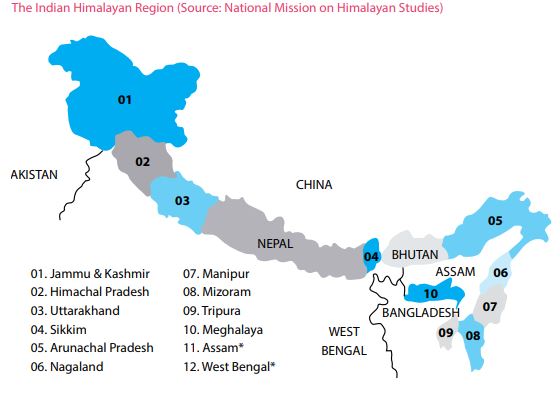ForumIAS announcing GS Foundation Program for UPSC CSE 2025-26 from 19 April. Click Here for more information.
ForumIAS Answer Writing Focus Group (AWFG) for Mains 2024 commencing from 24th June 2024. The Entrance Test for the program will be held on 28th April 2024 at 9 AM. To know more about the program visit: https://forumias.com/blog/awfg2024
Read In-depth analysis of all the Editorials here
News: The Department of Science and Technology (DST) will be commissioning a study to assess the climate risks faced by States in India.
What is vulnerability index?
Indian Himalayan region consists of 12 states.
Index is a state-level climate vulnerability assessment, being carried out for the Indian Himalayan Region (IHR). Indicators for this assessment are:
- Socioeconomic, demographic status and health
- population density,
- percentage marginal farmers,
- livestock to human ratio,
- per capita income,
- number of primary healthcare centers per 100,000 households and
- percentage of women in the overall workforce.
- sensitivity of agricultural production
- percentage area under irrigation,
- yield variability and
- percentage area under horticulture crops.
- forest dependent livelihoods and
- percentage area under open forests
- area under forests per 1,000 households
- access to information services and infrastructure
- percentage crop area insured under all Insurance Schemes,
- percentage farmers taking loans,
- average person days per household under MGNREGA,
- average percentage area with >30% slope, and
- road density
Need for vulnerability assessment
The Himalayan ecosystem is vital to the ecological security of the Indian landmass.
It plays a crucial role in:
- providing forest cover
- feeding perennial rivers that are the source of drinking water
- irrigation, and hydropower
- conserving biodiversity
- providing a rich base for high-value agriculture
- spectacular landscapes for sustainable tourism
Himalayan communities have a large dependency on climate sensitive sectors such as rainfed agriculture, and have a fragile mountain ecosystem.
The communities have limited livelihood options and experience higher marginalization because natural physical barriers. Under changing and variable climate, such constraints are likely to add to the vulnerability of Himalayan communities.
Vulnerability assessment can help in the identification of the drivers of vulnerability, and assist in designing adaptation interventions specific to the area.
State level vulnerability index
vulnerability index is found to be the highest for Assam (0.72) and Mizoram (0.71).
Sikkim is the least vulnerable state with the index being 0.42.
While the other states which are lying mid of the index are Jammu and Kashmir (0.62), Manipur (0.59), Meghalaya and West Bengal (both 0.58), Nagaland (0.57), Himachal Pradesh and Tripura (0.51 both), Arunachal Pradesh (0.47) and Uttarakhand (0.45).
It is to be noted here that if Sikkim is having least vulnerability, it is not in absolute sense but it is related to other state i.e. Sikkim might be highly vulnerable but it is lesser than other states.
Drivers of vulnerability in top 3 states
Assam has the least area under irrigation, least forest area available per 1,000 rural households and the second lowest per capita income among the other IHR states, and thus scores the highest vulnerability score.
Major drivers of vulnerability in Mizoram are highest yield variability, no area under crop insurance, largest area under open forests, and largest area under slope >30% as compared to other states.
While vulnerability of J&K is driven by least road density, no area under crop insurance, low area under forests per 1,000 rural households, high percentage of marginal farmers, low percentage area under horticulture crops, low livestock to human ratio and low percentage of women in the overall workforce.
Government Initiatives for Indian Himalayan states
National Mission for Sustaining the Himalayan Ecosystem (NMSHE)
National Mission for Sustaining the Himalayan Ecosystem (NMSHE) coordinated by the Department of Science and Technology, is one of the eight missions under India’s National Action Plan on Climate Change.
The broad objectives of NMSHE include –
- understanding of the complex processes affecting the Himalayan Ecosystem and evolve suitable management and policy measures for sustaining and safeguarding the Himalayan ecosystem,
- creating and building capacities in different domains,
- networking of knowledge institutions engaged in research and development of a coherent data base on Himalayan ecosystem,
- detecting and decoupling natural and anthropogenic induced signals of global environmental changes in mountain ecosystems,
- studying traditional knowledge systems for community participation in adaptation,
- mitigation and coping mechanisms inclusive of farming and traditional health care systems and developing regional cooperation with neighbouring countries,
- to generate a strong data base through monitoring and analysis,
Under NMSHE, State Climate Cells/Centers have been established in 11 out of the 12 Himalayan States for building institutional capacity of Himalayan States in the area of climate change adaptation. These centers are working on areas of climate vulnerability assessment, raising public awareness and training and capacity building for climate change adaptation planning.
Source: https://www.thehindu.com/todays-paper/tp-national/a-climate-vulnerability-index-for-india/article26539086.ece





